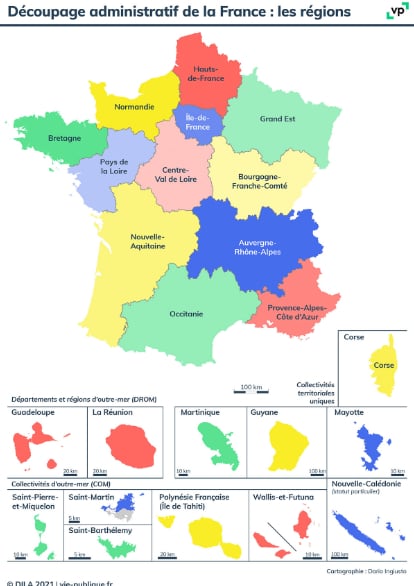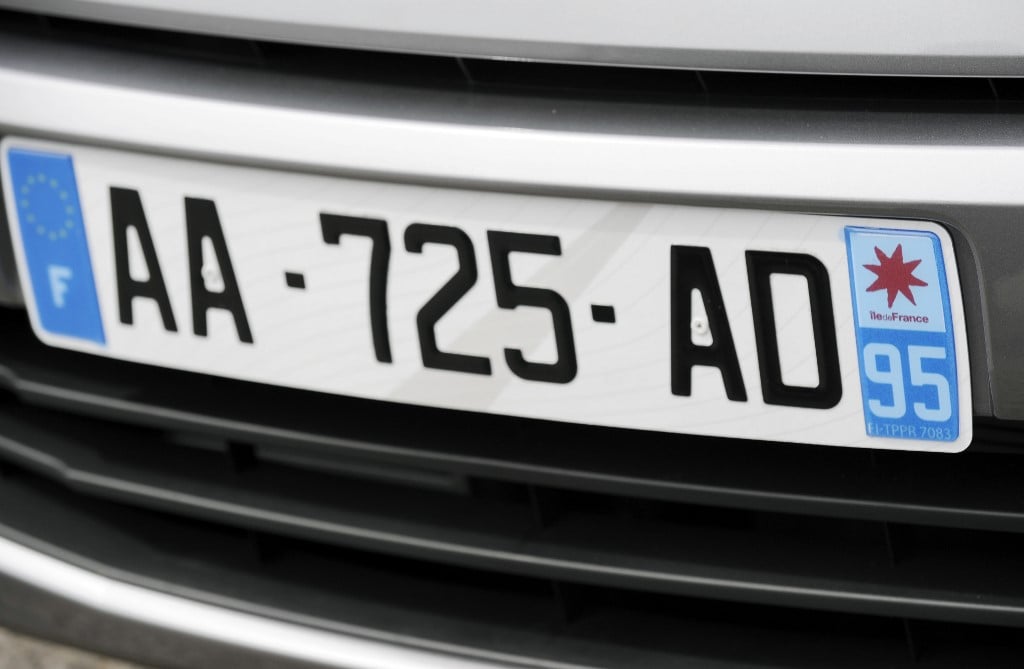Explained: Your French region, métropole, département and commune

If you're living in France you will obviously know your own address, but at various times you will also need to know your département, département number, region, commune, ville and even métropole.
Here's a quick breakdown of how France is divided up at a local level;
Region
Mainland France is divided into 13 regions which in addition to having regional councils also have regional health authorities known as Agence régionale de santé (ARS).

A map of France's region, with overseas territories added below. Map: Vie Publique
The areas covered by these regions are huge - Nouvelle Aquitaine in the south west covers 84,000 sq km and is larger than the entire country of Scotland - so if you hear that something is happening in your region it's worth checking a map, as the events could be more than 300km away from you and still be in the same region.
The current regions are; Auvergne-Rhône-Alpes, Bretagne, Bourgogne-Franche-Comté, Corse, Centre-Val-de-Loire, Grand-Est, Hauts-de-France, Île-de-France, Nouvelle-Aquitaine, Normandie, Occitanie, Pays-de-la-Loire and Provence-Alpes-Cote d'Azur.
The number of French regions was slimmed down in 2016 with several areas merging into new regions so you will still sometimes hear people refer to regions like Poitou-Charente and Picardie which don't technically exist any more.
Département
These are the French equivalent of counties and are probably the most widely used when it comes to things like weather warnings, drought alerts and various other important designations. They also have local governments known as préfectures which play a large role in local decision making.
There are 101 départements in France, five of which are outside 'the hexagon' as mainland France is known. These départements d'outre-mer (overseas départements) are: French Guiana in South America, Martinique and Gaudeloupe in the Caribbean and Réunion and Mayotte in the Indian Ocean. They are as much a part of France as Dodorgne or Paris and fall under the direct control of the French government.
Each mainland département has a two-digit number as well as a name, which forms the first part of your postcode and also appears on car number plates.
Official sources such as French government sites generally use both the name and number of a département, for example "Alpes-Maritime (06)" and French people quite often refer to their département by its number if you're asked which département you live in it's quite acceptable to reply seize instead of Charente.
You refer to it by the whole number, so Paris (75) is soixante-quinze rather than sept cinq (with the occasional exception of le neuf trois).

This car is registered in département number 95, Val d'Oise. Photo: AFP
Métropole
This designation refers to a city and its surrounding areas - suburbs and/or small towns surrounding the city. So for example the metropole of Aix-Marseille groups together 92 towns or suburbs around the big cities of Marseille and Aix-en-Provence. The métropole of Toulouse includes the city itself and 37 surrounding towns and suburbs.
Initially to be officially classed as métropole the urban area needed to have a population of over 400,000. But the rules have since been relaxed.
Certain métropoles such as Grand Nancy, Dijon and Toulon have a population of less than 300,000.
There are now 21 of these in France, centred around the largest cities - Grand Paris, Marseille, Bordeaux, Brest, Clermont-Ferrand, Dijon, Grenoble, Lille, Metz, Montpellier, Grand Nancy, Nantes, Nice, Orléans, Rennes, Rouen, Saint-Etienne, Strasbourg, Toulon, Toulouse and Tours.

Map: Superbenjamin/Wikimedia commons
Métropoles were only created in 2010 so they are relatively new administrative term. They were essentially created to help the country grow economically after the 2008 financial crisis and meant greater powers for local authorities on how the metropolitan areas are run.
The government website states: "In order to strengthen the regions, the status of métropole was created by the law of December 16, 2010 to promote the role of large urban conurbations as engines of growth and economic attractiveness in the country."
The overall aim of becoming a métropole is to bring together cities with the surrounding areas "in order to enhance the economy, transport networks and to develop universities, research and innovation resources. It also ensures the international promotion of the territory."
In total, around 11 million people live in a 'métropole' in France and that number may grow given more cities in France may apply to be granted the status of métropole.
In general conversation people may also use the term métropole to distinguish between mainland France and its overseas territories.
Commune
The commune is the lowest level of civil administration of France and there are more than 36,000 of them - each with their own mayor and local council.
They vary widely in size and population - some cover entire towns or cities others include just a couple of tiny villages. And some communes have no inhabitants at all - such as the six French towns which have a mayor but no residents.
Mayors have a wide range of powers - even those in tiny villages - and also have important ceremonial roles such as conduction weddings.
Paris
Paris forms a bit of an anomaly to some of these general rules - it is a city, a département and a commune and is also part of a metropole - Grand Paris. The area covered by Paris is only the part of the city inside the périphérique ring road, everything outside the ring road - which includes the Stade de France and both city airports - is part of the suburbs.
There are three départements that encircle Paris and form the inner suburbs, known as the petite couronne, they are; Seine-Saint Denis, Val-de-Marne and Hauts-de-Seine.
Paris has a mayor - currently Anne Hidalgo - but inhabitants of the city also elect a mayor for each arrondissement (district) of the city. Those who live in the suburbs elect a mayor via their commune.
Comments (1)
See Also
Here's a quick breakdown of how France is divided up at a local level;
Region
Mainland France is divided into 13 regions which in addition to having regional councils also have regional health authorities known as Agence régionale de santé (ARS).

The areas covered by these regions are huge - Nouvelle Aquitaine in the south west covers 84,000 sq km and is larger than the entire country of Scotland - so if you hear that something is happening in your region it's worth checking a map, as the events could be more than 300km away from you and still be in the same region.
The current regions are; Auvergne-Rhône-Alpes, Bretagne, Bourgogne-Franche-Comté, Corse, Centre-Val-de-Loire, Grand-Est, Hauts-de-France, Île-de-France, Nouvelle-Aquitaine, Normandie, Occitanie, Pays-de-la-Loire and Provence-Alpes-Cote d'Azur.
The number of French regions was slimmed down in 2016 with several areas merging into new regions so you will still sometimes hear people refer to regions like Poitou-Charente and Picardie which don't technically exist any more.
Département
These are the French equivalent of counties and are probably the most widely used when it comes to things like weather warnings, drought alerts and various other important designations. They also have local governments known as préfectures which play a large role in local decision making.
There are 101 départements in France, five of which are outside 'the hexagon' as mainland France is known. These départements d'outre-mer (overseas départements) are: French Guiana in South America, Martinique and Gaudeloupe in the Caribbean and Réunion and Mayotte in the Indian Ocean. They are as much a part of France as Dodorgne or Paris and fall under the direct control of the French government.
Each mainland département has a two-digit number as well as a name, which forms the first part of your postcode and also appears on car number plates.
Official sources such as French government sites generally use both the name and number of a département, for example "Alpes-Maritime (06)" and French people quite often refer to their département by its number if you're asked which département you live in it's quite acceptable to reply seize instead of Charente.
You refer to it by the whole number, so Paris (75) is soixante-quinze rather than sept cinq (with the occasional exception of le neuf trois).

This car is registered in département number 95, Val d'Oise. Photo: AFP
Métropole
This designation refers to a city and its surrounding areas - suburbs and/or small towns surrounding the city. So for example the metropole of Aix-Marseille groups together 92 towns or suburbs around the big cities of Marseille and Aix-en-Provence. The métropole of Toulouse includes the city itself and 37 surrounding towns and suburbs.
Initially to be officially classed as métropole the urban area needed to have a population of over 400,000. But the rules have since been relaxed.
Certain métropoles such as Grand Nancy, Dijon and Toulon have a population of less than 300,000.
There are now 21 of these in France, centred around the largest cities - Grand Paris, Marseille, Bordeaux, Brest, Clermont-Ferrand, Dijon, Grenoble, Lille, Metz, Montpellier, Grand Nancy, Nantes, Nice, Orléans, Rennes, Rouen, Saint-Etienne, Strasbourg, Toulon, Toulouse and Tours.

Map: Superbenjamin/Wikimedia commons
Métropoles were only created in 2010 so they are relatively new administrative term. They were essentially created to help the country grow economically after the 2008 financial crisis and meant greater powers for local authorities on how the metropolitan areas are run.
The government website states: "In order to strengthen the regions, the status of métropole was created by the law of December 16, 2010 to promote the role of large urban conurbations as engines of growth and economic attractiveness in the country."
The overall aim of becoming a métropole is to bring together cities with the surrounding areas "in order to enhance the economy, transport networks and to develop universities, research and innovation resources. It also ensures the international promotion of the territory."
In total, around 11 million people live in a 'métropole' in France and that number may grow given more cities in France may apply to be granted the status of métropole.
In general conversation people may also use the term métropole to distinguish between mainland France and its overseas territories.
Commune
The commune is the lowest level of civil administration of France and there are more than 36,000 of them - each with their own mayor and local council.
They vary widely in size and population - some cover entire towns or cities others include just a couple of tiny villages. And some communes have no inhabitants at all - such as the six French towns which have a mayor but no residents.
Mayors have a wide range of powers - even those in tiny villages - and also have important ceremonial roles such as conduction weddings.
Paris
Paris forms a bit of an anomaly to some of these general rules - it is a city, a département and a commune and is also part of a metropole - Grand Paris. The area covered by Paris is only the part of the city inside the périphérique ring road, everything outside the ring road - which includes the Stade de France and both city airports - is part of the suburbs.
There are three départements that encircle Paris and form the inner suburbs, known as the petite couronne, they are; Seine-Saint Denis, Val-de-Marne and Hauts-de-Seine.
Paris has a mayor - currently Anne Hidalgo - but inhabitants of the city also elect a mayor for each arrondissement (district) of the city. Those who live in the suburbs elect a mayor via their commune.
Join the conversation in our comments section below. Share your own views and experience and if you have a question or suggestion for our journalists then email us at [email protected].
Please keep comments civil, constructive and on topic – and make sure to read our terms of use before getting involved.
Please log in here to leave a comment.